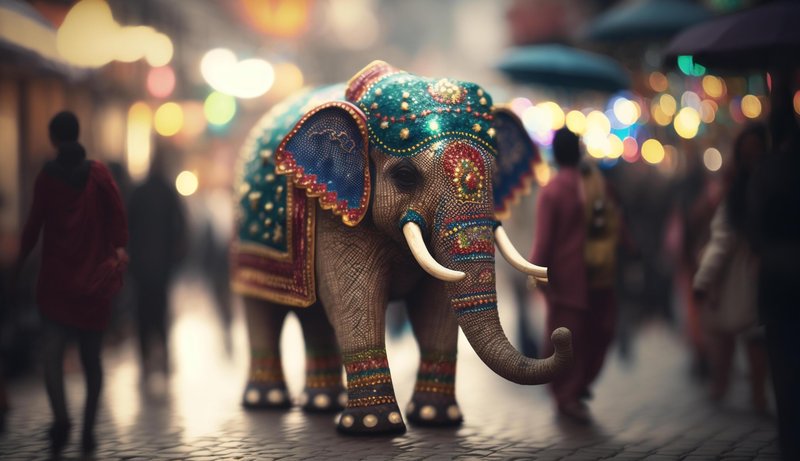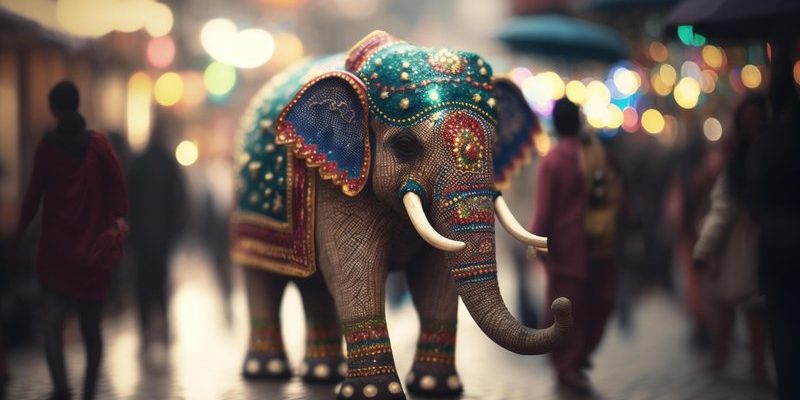
Here’s the thing: the Indian elephant isn’t just an animal; it’s a living symbol. Their presence in art, literature, and religious practices reveals how intertwined they are with the heartbeat of Indian society. Let’s explore how these gentle giants are represented in various aspects of culture and folklore, painting a vivid picture of their significance.
A Symbol of Wisdom and Strength
In many cultures, elephants are seen as symbols of wisdom and strength. In India, this representation is especially prominent. You might have encountered stories where an elephant saves a village or a child learns life’s lessons from these gentle giants. This isn’t just by chance. Throughout history, elephants have played crucial roles in labor, warfare, and even royal ceremonies. Their strength made them indispensable in transporting goods and people across rugged terrains, while their perceived intelligence made them wise companions.
In Hinduism, the elephant-headed god Ganesha embodies these traits. Ganesha is considered the remover of obstacles and a god of beginnings. His image can be found in homes and temples, often accompanied by the phrase, “Om Gan Ganapataye Namah.” This mantra signifies devotion and respect towards Ganesha, recognizing the elephant as a powerful symbol of guidance. You might be wondering how this translates into everyday life. Well, many people offer prayers to Ganesha before starting anything new, believing he will bless their endeavors with wisdom and success.
Elephants in Indian Mythology
Mythology is rich with references to elephants, often highlighting their importance in various legends. In the Ramayana, the majestic elephant Airavata is depicted as the mount of the god Indra. This heavenly creature is described as having multiple trunks and the power to create rain, symbolizing abundance and prosperity. These stories serve more than just entertainment; they highlight values and lessons.
Additionally, elephants are often featured in tales of great kings and warriors. For instance, the Mahabharata mentions battles fought with war elephants, illustrating their crucial role in historical conflicts. The vivid imagery of elephants charging into battle is not just thrilling; it emphasizes themes of bravery and loyalty. It’s as if these animals are more than mere beasts; they represent the spirit of the land.
Elephants in Traditional Art and Festival Celebrations
Art in India is colorful and diverse, and elephants often take center stage. In traditional Madhubani paintings or Warli art, elephants are depicted in various forms, symbolizing nature’s beauty and the bond between humans and animals. These artworks not only serve as decoration but also tell stories, portraying cultural beliefs and the social fabric of communities.
During festivals, elephants become living canvases. For example, in the vibrant Onam festival in Kerala, elephants are adorned with golden caparisons and intricate jewelry. It’s a breathtaking sight that brings people together, showcasing the cultural significance of elephants in celebration. Imagine witnessing a parade of beautifully decorated elephants, with their large ears flapping in rhythm to the drumbeats—it’s an experience that captures the heart and soul of Indian culture.
Folklore and Storytelling
Storytelling is a cherished tradition in India, and elephants often feature as important characters in these tales. Picture a grandmother sharing a cozy evening story of a clever elephant who outsmarts a greedy lion. These folklore stories are more than just entertainment; they impart moral lessons about honesty, bravery, and compassion.
One popular tale speaks of an elephant who helped a poor farmer by bringing water to his parched fields. The story emphasizes the value of friendship and mutual support. Folk tales like this create a connection between communities, encouraging respect for nature and empathy towards all living beings. Honestly, isn’t it remarkable how a simple story can convey such profound lessons?
Conservation and Modern Representation
As we step into the modern era, the representation of elephants has evolved, reflecting our changing relationship with nature. In recent years, there has been a strong push for elephant conservation, highlighting the need to protect these majestic creatures from poaching and habitat loss. Organizations across India work tirelessly to educate the public about the importance of elephants in ecosystems.
Moreover, movies and media have begun showcasing elephants in a more positive light, focusing on the bond between humans and elephants. Films often depict these gentle giants not just as animals, but as symbols of wisdom and companionship. This shift in representation plays a crucial role in advocating for their protection, ensuring that future generations will continue to appreciate the cultural significance of elephants.
The Indian elephant is more than just a creature of the wild; it is a symbol of strength, wisdom, and an integral part of India’s cultural heritage. From mythology to modern conservation efforts, these gentle giants continue to inspire stories and traditions that resonate with many. Their representation in art, folklore, and religious practices illustrates a deep-rooted respect for nature and the interconnectedness of life.
As we appreciate the presence of elephants in our culture, it’s essential to support efforts that protect them. Ensuring that these magnificent beings can thrive in their natural habitats benefits not only the elephants themselves but also the rich tapestry of culture and folklore they represent. Next time you think of Indian elephants, remember they carry stories of strength, courage, and friendship in their hearts.

